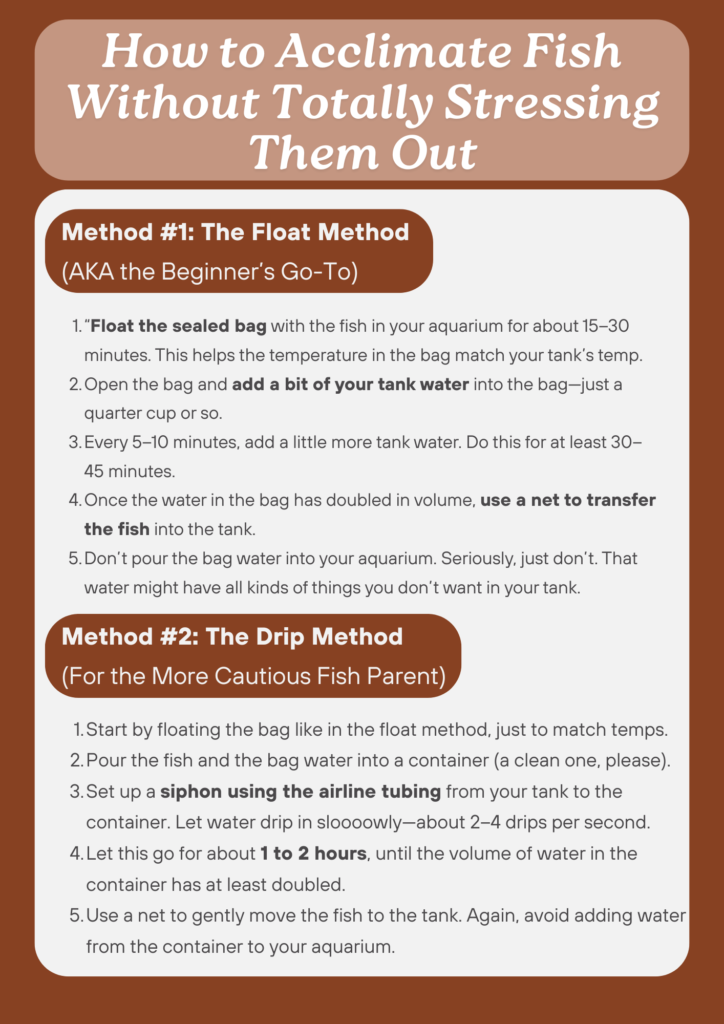So you’ve got a new fish—yay! Whether it’s your first or your fiftieth, bringing home a fish is always exciting. But here’s the thing: you can’t just plop your fish straight into the tank and call it a day. Nope. If you want your new finned friend to actually survive (and, y’know, thrive), you really gotta learn how to acclimate fish properly. Trust me, this part is super important and honestly, a lot of people either skip it or rush through it—and then wonder why their fish seem stressed or don’t make it past day one. Don’t worry though, it’s not hard at all. In fact, I’ll walk you through it in a totally chill, no-fancy-terms kind of way. Let’s get into it!
Why Acclimating Fish Is Kinda a Big Deal
Okay, real talk: fish are way more sensitive than we give them credit for. Like, they might look all cool and chill just swimming around, but even a small change in their environment can seriously mess them up. When you bring a fish home from the store, they’re used to that water—its temperature, pH level, hardness, you name it. Your tank? It’s a whole new world. And throwing them in without letting them adjust slowly can shock their little systems.
Think about it like jumping into an ice-cold pool after a hot shower. It’s a shock to your body, right? Now imagine you’re a tiny fish who can’t scream or complain. That’s what sudden changes feel like to them. So, acclimating is not just some aquarium nerd thing—it’s a must.

Method #1: The Float Method (AKA the Beginner’s Go-To)
This is the easiest and most popular method for new fish owners. It works well for freshwater fish that are fairly hardy—think guppies, tetras, mollies, and goldfish.
How to Do It:
- Float the sealed bag with the fish in your aquarium for about 15–30 minutes. This helps the temperature in the bag match your tank’s temp.
- Open the bag and add a bit of your tank water into the bag—just a quarter cup or so.
- Every 5–10 minutes, add a little more tank water. Do this for at least 30–45 minutes.
- Once the water in the bag has doubled in volume, use a net to transfer the fish into the tank.
- Don’t pour the bag water into your aquarium. Seriously, just don’t. That water might have all kinds of things you don’t want in your tank.
Pros:
- Super easy
- Quick
- Good for less sensitive fish
Cons:
- Not ideal for delicate or expensive species
Method #2: The Drip Method (For the More Cautious Fish Parent)
Now, if you’re bringing home saltwater fish or delicate freshwater types (like discus or certain shrimp), you might want to try the drip method. It’s more time-consuming but way gentler.
What You’ll Need:
- Airline tubing
- A bucket or clean container
- Some time (and a lil’ patience)
How It Works:
- Start by floating the bag like in the float method, just to match temps.
- Pour the fish and the bag water into a container (a clean one, please).
- Set up a siphon using the airline tubing from your tank to the container. Let water drip in sloooowly—about 2–4 drips per second.
- Let this go for about 1 to 2 hours, until the volume of water in the container has at least doubled.
- Use a net to gently move the fish to the tank. Again, avoid adding water from the container to your aquarium.
Pros:
- Best for sensitive fish
- Super gentle transition
Cons:
- Takes longer
- You need a few extra tools
Common Mistakes (We’ve All Been There)
Look, nobody’s perfect. I’ve made a few of these myself, so no judgment if you have too. Just try not to do them again, cool?
- Dumping the fish right into the tank: Please don’t. We already talked about this.
- Pouring bag water into the aquarium: Nope. Bad idea. That water can carry diseases or stress hormones from the pet store.
- Not matching the temperature: This is a biggie. A sudden temp change can stress fish out big time.
- Skipping acclimation altogether: It’s tempting, especially if you’re tired or in a rush. But fish shock is real—and often fatal.
Some Extra Tips for Success
Just a few bonus things that’ll make the whole acclimation thing even smoother:
- Dim the lights in the room or tank. Fish hate harsh light when they’re already stressed.
- Don’t feed them right away. Let your fish settle in for a few hours before tossing in food.
- Test your water parameters before adding new fish. Make sure the pH, ammonia, nitrites, and nitrates are all in the safe range.
- Quarantine if you can. I know, not everyone has space for a separate tank, but it can save your whole tank from illness.
Final Thoughts: Just Take It Slow
That’s it! Honestly, once you get the hang of how to acclimate fish, it becomes second nature. It might seem like a lot at first, but once you’ve done it a couple times, you’ll be a pro. Whether you’re using the float method for your neon tetras or the drip method for your pricey saltwater fish, just remember—slow and steady wins the fish race.
And hey, don’t stress too much if you don’t get it perfect on your first try. We all learn as we go. The important thing is that you’re trying to do right by your new little water buddies, and they’ll appreciate that (in their own quiet, fishy way).

